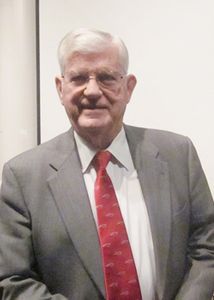
Former N.C. Governor, Dr. James G. Martin, spoke at Catawba College’s January Community Forum and attempted to reconcile the centuries old conflict between science and religion. Martin, a respected Davidson College chemistry professor long before his decades-long foray into politics, shared scientific occurrences across many disciplines that seemed to indicate the hand of a higher power or God at work, rather than sheer coincidence.
To many in the audience, Martin’s profound grasp and breadth of science was confounding; they gathered instead his inferences, while making their own personal assessments of this learned man who shared his reconciliatory thoughts on his faith and science.
Martin took his audience on a journey back in time. He cited early conflicts between science and religion, noting the troubles that Galileo’s telescope and his contention in support of Copernicus’ theory that the sun is the center of our galaxy caused, and the uproar that surrounded Darwin’s “Origin of the Species” and its still ongoing evolutionary debate.
He likened modern science to “contemporary revelation,” and said modern science offers “the best method for discovering and understanding nature.” And modern science, he added, “need not be an impediment to your faith.”
“My point of view is that you can believe in God and evolution,” he declared. “Science has evidence that supports my faith.”
He shared that on the 500th birthday of Copernicus, scientist and author Brandon Carter put forth his “anthropic principle” which posits that “somehow the universe was expecting us.”
Carter’s principle implied, Martin explained, that “our universe is extremely fine-tuned, otherwise, life could not arise.”
He cited American physician-geneticist and author Francis Collins from his text, “The Language of God: A Scientist Presents Evidence for Belief,” who shared three alternatives in an explanation of why Earth and its life exists: 1) there is an infinite number of universes with planets like Earth, but Earth is the only one we know at present; 2) Earth is the only place in the universe fortuitous enough to have life; or 3) Earth and its life is the only one of its kind and its existence reflects the values of a creator.
More anthropic coincidences, Martin said, can be found in the complexity of the eye, the heart, and the body’s complex redundant immune functions.
Earth was formed 4.6 billion years ago, but around the 530-520 million year span, during the Cambrian Period, there was an eruption of new body forms or phyla, he shared. There have been no new phyla since then, but rather a decline or extinction of certain forms.
“We find God in what we know, not in what we don’t know,” Martin said, alluding to a 1945 quote from German Lutheran pastor and theologian Dietrich Bonhoeffer.
He pointed out anthropic coincidences in chemistry and biology, the complexity of the DNA code, noting human DNA has 3.1 billion rings of base pairs and asking, “What are the odds of getting the codes right?” He noted the delicate balance of proteins interacting to generate cell growth.
“That’s a wow,” he exclaimed, and queried his listeners, “Are you beginning to see something going on here?”
Among his concluding remarks, Martin pointed to the PowerPoint image of a turtle sitting atop a fence post, and likened that turtle to man existing on Earth, quipping, “He knew he didn’t get there by himself.”
“I’m not a theologian, but I’m saying science and religion don’t necessarily conflict. There’s support for things unseen. We see evidence that strengthens belief.”
